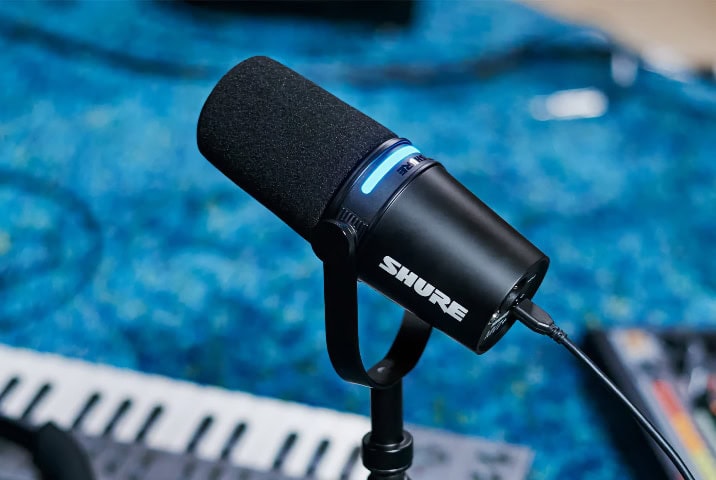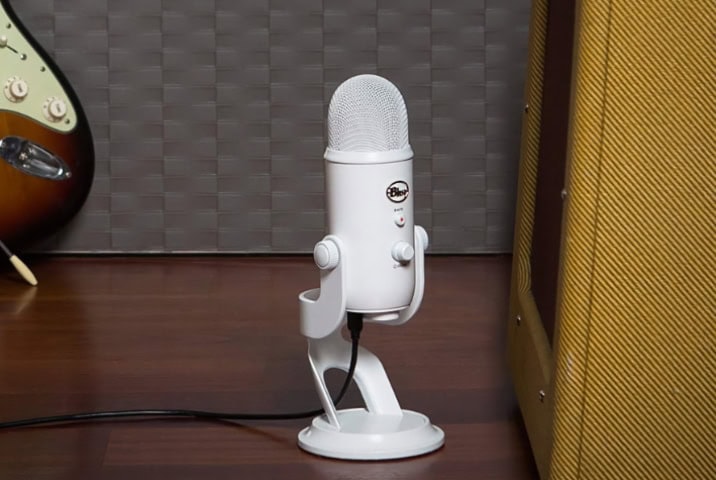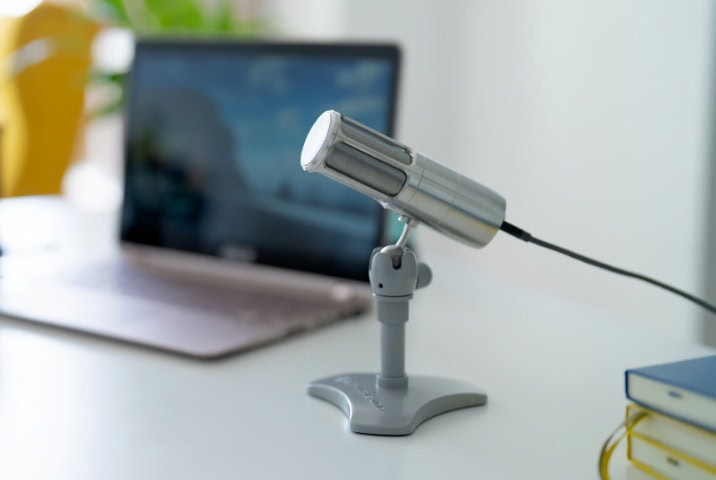USB microphones aren’t very different from your standard mic, except for the fact that they contain within them a dedicated preamp as well as an analog-to-digital converter. This makes them incredibly convenient, simple, and portable, as you only need one connection.
The Shure MV7+ tops my list as the best USB microphone for vocals and studio recording. It offers both USB and XLR connectivity, making it one of the most versatile choices on this list.
The Blue Yeti is a close runner-up. As a condenser microphone with switchable polar patterns, it proves useful in a wide range of recording situations.
Lastly, for those on a tighter budget, the Audio-Technica AT2005USB offers flexibility and versatility at an extremely low price.
Contents
Use these jump links to navigate to the desired section of the review.
Why you should trust me

I’ve been writing, performing, recording, mixing, and producing music for over 15 years.
I have had experience in a vast array of genres, studio settings, and have worked and collaborated with countless artists and brands.
Working with names such as Shure, AKG, Neumann, and Sennheiser, among many others, has lent me nuanced insights into the practical application of audio equipment, and what value it provides users ranging from novice to seasoned professionals.
How I chose and tested
Historically, USB microphones haven’t proven to be the most suitable for serious audio recording. This is because sometimes the digital circuitry within the microphone may introduce noise or distortion to your recordings, especially when the signal being captured is at low volumes.
However, they cut out the need for an audio interface, preamps, and mic stands, which can save you a whole lot of money. This makes them fantastic choices for beginner producers, podcasters as well as casual demo recordings.
That being said, as technology has continued to improve, so has the viability of USB microphones contending in more professional recording applications.
When selecting the microphones for this list, I considered a few factors such as frequency response, versatility, as well as price. I tried to include a mix of classics as well as more affordable options that still offer solid performance.
Keep in mind that the best microphone ultimately depends on your own personal preference, voice, and the desired result.
Here’s my pick of the best USB microphones for vocals and music recording:
- Best USB condenser: Audio-Technica AT2020USB-X
- Best hybrid microphone: Shure MV7+
- Best multi-pattern condenser: Blue Yeti
- Best for rich, warm vocals: Earthworks Icon
- Best budget pick: Audio-Technica AT2005USB
Check the Honorable mentions for a few other USB mics that didn’t make the main list.
Best USB condenser: Audio-Technica AT2020USB-X
- Type: Condenser
- Polar pattern: Cardioid
- Frequency response: 20 Hz – 20 kHz
- A/D resolution: 24-bit/96 kHz
- Output connector: USB-C
- Headphone jack: Yes, 1/8″ TRS

The AT2020USB-X is the upgraded version of AT2020USB+, and while it may seem as if the only change is in the slight alteration within the name, there is a huge difference.
The AT2020USB-X features a headphone jack with level control, as well as a dial to allow you to mix the incoming signal from pre-recorded audio with the microphone’s signal. The A/D converter is of higher quality as well, allowing you to record with virtually zero latency.
Ultimately, this is one of the best USB microphones you can buy for any sort of voice work. As a condenser, it is incredibly sensitive, and its sound quality is rather clear and transparent for the price.
What I like
- Headphone jack with level control for real-time monitoring.
- High resolution A/D conversion.
- Great cost-to-value ratio.
What I don’t like
- Nothing to note so far.
Best hybrid microphone: Shure MV7+
- Type: Dynamic
- Polar pattern: Cardioid
- Frequency response: 50 Hz – 16 kHz
- A/D resolution: 24-bit/48 kHz
- Output connector: USB-C, XLR
- Headphone jack: Yes, 1/8″ TRS

The MV7+ is interesting because it offers both USB and XLR outputs, allowing you to record however you prefer. For this reason, this microphone is arguably the most practical choice on this list, at least as far as serious recording is concerned.
It’s particularly adept at rejecting unwanted background noise from your recording sessions, giving you a clean, dry signal.
The MV7+ has earned its place as the microphone of choice for a great number of podcast hosts and content creators, and in all honesty, it’s probably the best USB microphone you can find on the market.
What I like
- Has both USB and XLR outputs, making it flexible for different setups.
- Rejects unwanted background noise.
What I don’t like
- Slightly pricier compared to other USB mics.
Best multi-pattern condenser: Blue Yeti
- Type: Condenser
- Polar pattern: Cardioid, bidirectional, omnidirectional, stereo
- Frequency response: 20 Hz – 20 kHz
- A/D resolution: 16-bit/48 kHz
- Output connector: Mini-USB
- Headphone jack: Yes, 1/8″ TRS

For just around $140, the Blue Yeti is well worth the price. The microphone can switch between four polar patterns: cardioid (front-facing), bidirectional (facing both front and back), omnidirectional (all angles), and stereo (right and left).
This added feature allows the Yeti to be extremely helpful in many recording situations. It has an extremely accurate quality in its sound, and it comes with a no-latency headphone jack and gain control.
What I like
- Versatile with four selectable polar patterns.
- Accurate sound.
What I don’t like
- Design is large and bulky, making it slightly less portable.
Best for rich, warm vocals: Earthworks Icon
- Type: Condenser
- Polar pattern: Cardioid
- Frequency response: 20 Hz – 20 kHz
- A/D resolution: 16-bit/48 kHz
- Output connector: Micro-USB
- Headphone jack: Yes, 1/8″ TRS

The Icon is actually the first USB microphone ever offered by Earthworks, and I was rather impressed with the results. It offers an incredibly warm and rich performance for a USB microphone, and the resolution is phenomenal.
The microphone has a stainless steel body, making it durable as well as attractive to look at.
The only downside here is its price point. Even though it’s worth the money, I can definitely see this deterring many folks looking for a more affordable solution. Nevertheless, if you’re willing to invest, you won’t be disappointed.
What I like
- Amazing sound quality.
- Great A/D conversions.
- Durable.
What I don’t like
- Somewhat expensive.
Best budget pick: Audio-Technica AT2005USB
- Type: Dynamic
- Polar pattern: Cardioid
- Frequency response: 50 Hz – 15 kHz
- A/D resolution: 24-bit/48 kHz
- Output connector: Mini-USB, XLR
- Headphone jack: Yes, 1/8″ TRS

The AT2005USB is a pretty great mic considering it’s priced at a mere $80. It’s capable of both USB and XLR connections, making recording a lot easier. The frequency response of this microphone is a bit lacking, but it’s really not a big deal for the price.
Thanks to its XLR output, the AT2005USB is quite useful for recording acoustic guitars and other acoustic instruments as well. I highly recommend this microphone for anybody with a limited budget, and who wants a bit more flexibility out of their mic.
What I like
- Offers both USB and XLR connections.
- Affordable.
What I don’t like
- Sound quality isn’t as great as other mics listed.
Honorable mentions
Here are a few more USB microphones that I like:
- Rode NT-USB. A really solid choice as far as USB microphones are concerned. It features a headphone monitoring jack and a mix control for zero-latency recording. The NT-USB also comes with a handy pop filter that attaches directly to the base of the mic.
- Rode Podcaster. This is a dynamic cardioid mic with a fairly flat frequency response, featuring a slight boost in higher ranges around 10 kHz. It’s incredibly durable too, so you won’t need to worry about dropping it by accident. On the downside, it’s quite expensive at its regular price of $230. However, if you find it on sale, its performance is on par with similar USB mics.
Conclusion
There you have it, my recommendations for the best USB microphones for recording vocals and music in 2025.
There are tens of other microphones out there that may very well be perfect for you, but I just couldn’t cover all of them. Hopefully, though, you’ve been able to find some helpful information about what makes these microphones great.
